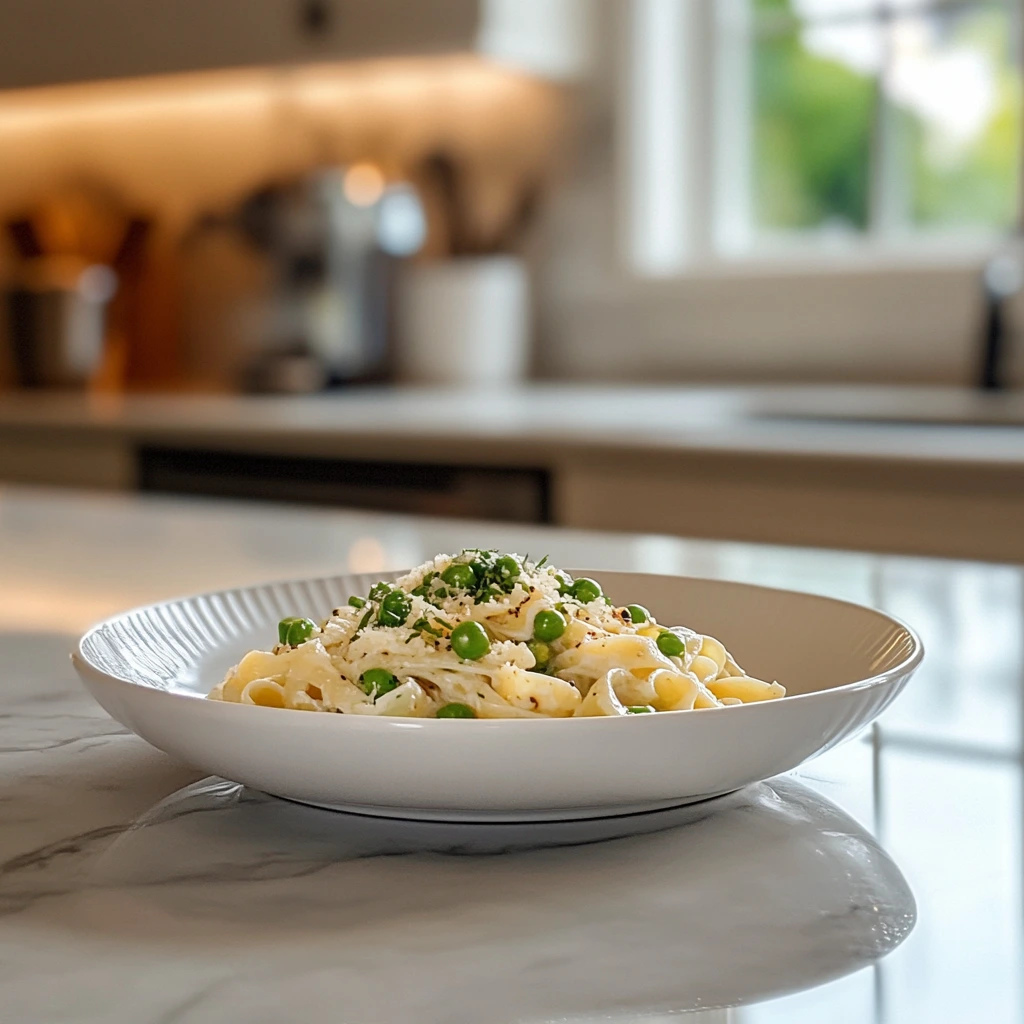Discover the enduring charm of this classic pasta and peas recipe, a dish that has transcended generations and borders with its simplicity, elegance, and robust flavor. In this comprehensive guide, we delve deep into its rich history, dissect the essential ingredients and their nutritional benefits, and provide a thoroughly detailed, step-by-step method to master the art of preparing this dish. Whether you are a seasoned culinary expert or a passionate home cook, this article will enhance your cooking repertoire and elevate your meal planning.
Introduction
Welcome to your ultimate guide on creating a perfect pasta and peas recipe. In this article, you will find:
- A detailed overview of the dish including its cultural roots and evolution
- Extensively detailed, step-by-step instructions for achieving restaurant-quality results
- Insightful expert tips to add your personal twist while troubleshooting common cooking challenges
- A robust FAQ section addressing popular questions and concerns
- In-depth nutritional insights highlighting the benefits of each ingredient
Background & History
The union of pasta and peas represents more than just a fusion of ingredients—it is a celebration of Italian culinary tradition and innovation. Over the decades, this dish has evolved while retaining its core simplicity.
- Historical Origins:
- Rustic Beginnings:
- Born in humble Italian kitchens where cooks ingeniously combined readily available seasonal ingredients.
- Initially a frugal yet hearty meal, perfect for feeding families using simple, accessible items.
- Cultural Impact:
- Became a symbol of resourcefulness and culinary creativity in regions with limited ingredients.
- Its timeless appeal has made it a staple in both home kitchens and fine dining adaptations.
- Rustic Beginnings:
- Evolution Over Time:
- Adaptation to Modern Tastes:
- While maintaining its rustic charm, modern variations incorporate gourmet elements and refined techniques.
- Chefs now experiment with different pasta shapes, innovative ingredients, and fusion flavors.
- Global Influence:
- The dish has found international acclaim, inspiring numerous adaptations that blend local flavors with Italian tradition.
- It is celebrated not only for its flavor but also for its nutritional balance and ease of preparation.
- Adaptation to Modern Tastes:

Pasta and Peas
Equipment
- Large pot
- Colander
- Sauté Pan
- Mixing Utensils
- Measuring Cup
Ingredients
Main Ingredients
- 12 oz pasta (penne, spaghetti, or fusilli) Use premium durum wheat pasta
- 1 cup peas Fresh or frozen
Complementary Ingredients
- 2 cloves garlic Minced
- 2 tbsp olive oil Extra virgin
- 1/2 cup Parmesan cheese Grated
- 2 tbsp fresh herbs (basil, mint, or parsley) Chopped
- 1 lemon juice Optional, for brightness
- 1/2 tsp red pepper flakes Optional, for heat
Instructions
- Bring a large pot of salted water to a boil.
- Add the pasta and cook until al dente. Reserve 1 cup of pasta water before draining.
- Blanch the peas in boiling water for 1-2 minutes, then drain.
- Heat olive oil in a sauté pan over medium heat and add minced garlic. Sauté until fragrant.
- Add the peas and cook for 2-3 minutes until vibrant and tender.
- Return the drained pasta to the pan. Gradually add the reserved pasta water while stirring to form a light sauce.
- Stir in grated Parmesan cheese until well combined.
- Finish with fresh herbs, a squeeze of lemon juice, and red pepper flakes if desired.
Notes
Plating and Presentation
- Garnishing Ideas:
- Top the dish with extra Parmesan for a richer taste.
- Drizzle a final bit of high-quality olive oil.
- Sprinkle freshly ground black pepper and red pepper flakes to add a layer of complexity.
- Serving Suggestions:
- Serve the dish warm on a pre-warmed plate to maintain optimal temperature.
- Pair with a fresh, crunchy green salad or a slice of crusty bread to soak up the sauce.
- For a festive touch, add a garnish of microgreens or edible flowers for visual appeal.
Tips, Variations, and Expert Advice

Personalize your pasta and peas recipe with these creative suggestions and expert insights:
- Flavor Variations:
- Protein Additions:
- Bacon or Pancetta: Crisp up for a salty, savory crunch.
- Chicken: Adds substance and a hearty flavor profile.
- Vegetable Enhancements:
- Asparagus, Spinach, or Cherry Tomatoes: These vegetables can bring extra color, texture, and seasonal freshness.
- Spice It Up:
- Incorporate red pepper flakes or a dash of smoked paprika for an unexpected kick.
- Protein Additions:
- Dietary Adaptations:
- Vegan Option:
- Replace Parmesan with nutritional yeast or a vegan cheese alternative.
- Ensure the pasta is free of eggs and other animal products.
- Gluten-Free Option:
- Use high-quality gluten-free pasta that maintains the texture and flavor of traditional pasta.
- Vegan Option:
- Cooking Tips:
- Perfect Pasta Texture:
- Monitor the cooking time closely; test a piece a couple of minutes before the recommended time.
- Creating a Creamy Sauce Without Cream:
- Use the natural starch from the pasta water combined with Parmesan to achieve a smooth, emulsified sauce.
- Expert Finishing Touches:
- Drizzle with extra virgin olive oil and freshly ground pepper just before serving to enhance the overall flavor profile.
- Perfect Pasta Texture:
Nutritional Benefits
- Balanced Nutrition:
- A combination of carbohydrates from pasta and proteins and fibers from peas creates a well-rounded meal.
- Health Boost:
- The antioxidants in fresh peas and the heart-healthy fats in olive oil make this dish both delicious and beneficial.
- Low-Calorie Delight:
- A satisfying yet light option that can fit into various dietary plans, ideal for those seeking nutritious comfort food.
Serving Suggestions and Pairings

Elevate your pasta and peas recipe with creative serving ideas and pairing suggestions that cater to different dining experiences:
- Complementary Sides:
- Fresh Salads:
- A light arugula or mixed greens salad dressed with a citrusy lemon vinaigrette can provide a refreshing contrast.
- Crispy Bread:
- Serve alongside rustic artisan bread or a freshly baked baguette to soak up the flavorful sauce.
- Beverage Pairings:
- A chilled glass of white wine such as Pinot Grigio or Sauvignon Blanc complements the dish perfectly.
- Sparkling water with a twist of lemon offers a non-alcoholic alternative.
- Fresh Salads:
- Presentation Ideas:
- Casual Dining:
- Serve in a large, family-style bowl that invites everyone to share and enjoy together.
- Elegant Entertaining:
- Plate individually on warm, elegant dishes, garnished with microgreens and a light drizzle of olive oil for a refined presentation.
- Seasonal Twists:
- Spring/Summer: Incorporate fresh herbs and citrus elements to enhance the dish’s brightness.
- Autumn/Winter: Consider adding roasted garlic or a hint of nutmeg for a warm, comforting flavor profile.
- Casual Dining:
Troubleshooting Common Issues
Even with a detailed recipe, challenges can arise. Here are some tips to ensure your pasta and peas recipe comes out perfectly every time:
- Pasta Texture Issues:
- Overcooked Pasta:
- Test a few minutes before the suggested cooking time. If the pasta becomes too soft, rinse briefly with cold water and gently reheat with reserved pasta water.
- Undercooked Pasta:
- If the pasta is too firm, return it to the boiling water for a minute or two before assembling with the peas.
- Overcooked Pasta:
- Flavor Imbalance:
- If the dish feels bland, adjust by adding a pinch more salt or a squeeze of lemon juice to brighten the flavors.
- Enhance the overall taste with a final sprinkle of freshly ground black pepper or red pepper flakes.
- Pea Texture Issues:
- Blanch the peas for exactly 2 to 3 minutes. Over-blanching may result in a loss of both vibrant color and texture.
Following these troubleshooting tips will help you maintain the perfect balance of flavors and textures in your pasta and peas recipe.
Frequently Asked Questions (FAQ)
Below are some of the most common questions about this pasta and peas recipe along with detailed answers:
- What type of pasta works best for this recipe?
- Recommended Pasta:
- Use pasta such as penne, spaghetti, or fusilli because they are excellent at holding the light, flavorful sauce and complementing the texture of the peas.
- Recommended Pasta:
- Can frozen peas be used instead of fresh?
- Using Frozen Peas:
- Yes, frozen peas are an excellent alternative when fresh peas are not available. Ensure you do not overcook them to maintain their crisp texture and bright color.
- Using Frozen Peas:
- How can I achieve a creamy consistency without using cream?
- Creamy Sauce Tip:
- Combine the reserved pasta water with grated Parmesan cheese. The natural starch in the water helps emulsify the sauce, creating a smooth and light creaminess without the need for heavy cream.
- Creamy Sauce Tip:
- What variations can be added to this recipe?
- Variations and Enhancements:
- Consider adding proteins like bacon, pancetta, or chicken for a heartier dish.
- Experiment with additional vegetables such as cherry tomatoes, spinach, or asparagus for extra flavor and nutritional boost.
- Variations and Enhancements:
- Is it possible to adapt this recipe for a vegan or gluten-free diet?
- Dietary Adaptations:
- Absolutely. For a vegan version, substitute Parmesan with nutritional yeast or a plant-based cheese alternative and use egg-free pasta.
- For a gluten-free option, choose high-quality gluten-free pasta that replicates the texture and flavor of traditional pasta.
- Dietary Adaptations:
- Can this recipe be made ahead of time or reheated?
- Make-Ahead Tips:
- Yes, store the dish in an airtight container. When reheating, add a splash of water to restore the sauce’s creaminess and gently heat to avoid overcooking the pasta.
- Make-Ahead Tips:
For more creative ways to use leftovers and transform them into new culinary delights, please visit our creative leftover pasta recipes.
Conclusion
This extensive guide to the pasta and peas recipe has provided you with:
- A rich historical perspective on the dish’s evolution from rustic origins to a modern culinary favorite.
- Detailed, step-by-step instructions covering every stage—from preparation to final presentation.
- Expert tips and creative variations to help you customize the dish to your taste.
- Comprehensive troubleshooting advice to address common cooking challenges.
- Innovative serving suggestions that cater to both casual meals and elegant dining experiences.
We encourage you to experiment with this versatile recipe, adapting it to your preferences while enjoying the authentic taste of Italian cuisine. For further culinary inspiration and additional recipes, explore our internal guide such as lobster pasta delights, or expand your culinary horizons with insights from BBC Good Food.
Bon appétit and happy cooking as you embark on your journey to master this delightful pasta and peas recipe and explore the rich world of Italian-inspired cuisine!

